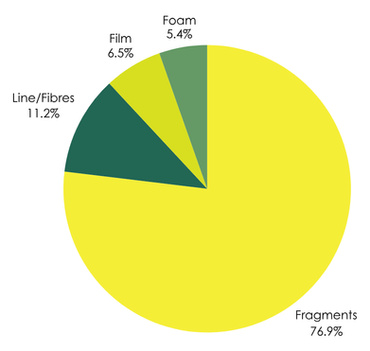What’s in the Water? A Closer Look at Prince Rupert’s Microplastics Pollution
- Maddie P.
- Apr 29
- 3 min read
Updated: Jun 15
For the past three years, the North Coast Ecology Centre Society (NCECS) has been investigating microplastics in Prince Rupert’s waters. This citizen science project aimed to find out where microplastics are showing up, what kinds are most common, and where they might be coming from. With help from Ocean Diagnostics Inc. (ODI) and funding from the Department of Fisheries and Oceans Canada, we set out to get a more clear picture of plastic pollution in our region.

Read the full report here:
What are microplastics?
Microplastics are any plastic item that is smaller than 5mm. They can be primary microplastics, which are made to be tiny, such as microbeads, or secondary microplastics, which come from larger plastic items that have broken down over time.

Microplastics are harmful to both human and ecosystem health. If ingested, they can harm animals by clogging or puncturing their digestive systems. These plastics also leach toxic chemicals, which may cause issues like liver damage, reproductive problems, and stress at the cellular level.
Microplastics are defined by their shape and chemical composition. If we have both, we can get an idea of where they come from.
Although we know microplastics are harmful, very little was known about them in our region... until now!
Our Project
This project was a collaboration between the North Coast Ecology Centre Society (NCECS) and Ocean Diagnostics Inc. (ODI) through support from the Department of Fisheries & Oceans Canada’s (DFO) Coastal Environmental Baseline Program. The goal was to establish a baseline for microplastic pollution in the Prince Rupert region and identify potential sources. We wanted to know:

Where are they showing up?
When are they most common?
What types occur most frequently?
What are the main sources?
What did we do?
Between September 2023 and March 2025, we collected sediment samples from seven sites. Five sites were sampled monthly, and two were sampled quarterly due to logistical constraints. Samples were processed using sieves, documented, and then shipped to ODI, where they could be analyzed further for their chemical properties.
What did we find?
PVC was the most common plastic overall, especially at Port Edward and Hospital Island.
More remote sites had fewer microplastics.
Fragments made up 77% of microplastics, which come from the breakdown of larger items.
Fibres and films made up 11% of plastics.
These results suggest a mix of plastic sources, from everyday litter to fishing gear and synthetic clothing.
Implications
Understanding what kinds of microplastics are in our waters and where they come from helps us target these pollutants at their source.
Fragments and foams come from larger items, such as bottles or packaging.
Fibres often come from synthetic clothes or marine gear, such as ropes and nets.
Chemical clues: Plastics like polyethylene and PVC are found in bags, wrappers, toys, and containers, making it hard to trace them to a specific source.
Call to Action!
There’s no single solution, but there are many small steps you can take:
Reduce your plastic use: Bring a reusable bag, mug, or water bottle.
Shop smart: Choose natural fabrics and avoid fast fashion when possible.
Pick up litter: Every piece you remove is one less in the ocean.
Spread awareness: Talk about the issue with your community.
Join us! Citizen science projects like this one are a great way to learn and make a difference. See ODI's citizen science toolkit here to learn how to start a project of your own!
Read More!
Check out the full report to dive deeper into our findings, learn more about microplastic pollution in Prince Rupert, and find out how you can help protect our local ecosystems.











Comments